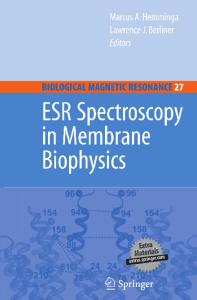Structural insights on biologically relevant cationic membranes by ESR spectroscopy
- PDF / 2,009,184 Bytes
- 15 Pages / 595.276 x 790.866 pts Page_size
- 88 Downloads / 311 Views
REVIEW
Structural insights on biologically relevant cationic membranes by ESR spectroscopy Julio H. K. Rozenfeld 1 & Evandro L. Duarte 2 & Tiago R. Oliveira 3 & M. Teresa Lamy 2
Received: 17 June 2017 / Accepted: 28 July 2017 / Published online: 23 August 2017 # International Union for Pure and Applied Biophysics (IUPAB) and Springer-Verlag GmbH Germany 2017
Abstract Cationic bilayers have been used as models to study membrane fusion, templates for polymerization and deposition of materials, carriers of nucleic acids and hydrophobic drugs, microbicidal agents and vaccine adjuvants. The versatility of these membranes depends on their structure. Electron spin resonance (ESR) spectroscopy is a powerful technique that employs hydrophobic spin labels to probe membrane structure and packing. The focus of this review is the extensive structural characterization of cationic membranes prepared with dioctadecyldimethylammonium bromide or diC14-amidine to illustrate how ESR spectroscopy can provide important structural information on bilayer thermotropic behavior, gel and fluid phases, phase coexistence, presence of bilayer interdigitation, membrane fusion and interactions with other biologically relevant molecules.
Keywords Cationic membranes . ESR spectroscopy . Spin labels . Lipid bilayers
This article is part of a Special Issue on ‘Latin America’ edited by Pietro Ciancaglini and Rosangela Itri. * M. Teresa Lamy [email protected]; http://fig.if.usp.br/~mtlamy/ 1
Departamento de Biofísica, Escola Paulista de Medicina, Universidade Federal de São Paulo, R. Botucatu 862, São Paulo, SP 04023-062, Brazil
2
Instituto de Física, Universidade de São Paulo, R. do Matão 1371, São Paulo, SP 05508-090, Brazil
3
Centro de Engenharia, Modelagem e Ciências Sociais Aplicadas, Universidade Federal do ABC, R. Arcturus (Jd Antares), São Bernardo do Campo, SP, Brazil
Introduction Membranes formed by synthetic cationic lipids were initially used to investigate membrane fusion and protein reconstitution (Südholter et al. 1982; Engberts and Hoekstra 1995). Establishment of their safety then led to cationic membranes being then employed as carriers of proteins and nucleic acids to eukaryotic cells (Zelphati et al. 2001; ur Rehman et al. 2013). This technical development enabled the study of gene function, silencing and therapy (Caracciolo and Amenitsch 2012) and stimulated the development of dozens of lipids with different cationic headgroups and hydrophobic moieties (ur Rehman et al. 2013; Junquera and Aicart 2016; Majzoub et al. 2016). In this review we focus on membranes formed by two cationic lipids: dioctadecyldimethylammonium bromide (DODAB) and diC14-amidine (Fig. 1). Versatile DODAB membranes have been used as nucleic acid (Silva et al. 2011) and hydrophobic drug carriers (Oliveira et al. 2011; Vieira et al. 2006), as templates for polymerization and deposition of materials (Hubert et al. 2000), as biomimetic particles (Rosa et al. 2008), as microbicidal agents (Ragioto et al. 2014) and as vaccine adjuvants (Rozenfeld et al. 2012;
Data Loading...











